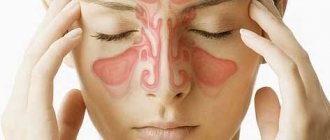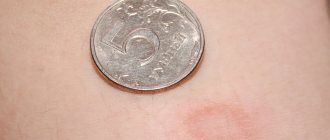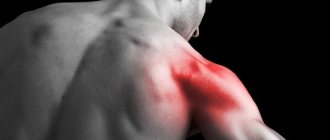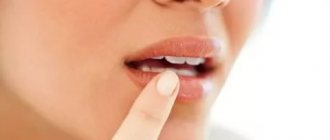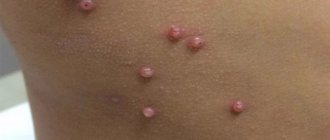Common causes of goose bumps
The reason for this is muscle contraction around the hair follicles. This is an evolutionary atavism with the help of which wild animals protect themselves in case of danger by grouping and increasing their body area.
In humans, this ability has practically disappeared, and only reminds us of itself when goosebumps run through the body. This often happens when we feel an emotional surge (delight, horror, excitement or religious ecstasy) or simply freeze.
A similar sensation occurs when the body suffers from a lack of oxygen or blood in the tissues. Natural, non-pathological goosebumps are not accompanied by pain. If paresthesia bothers you often and for no reason and is accompanied by numbness and pain in the limbs, you should consult a doctor.
In a normal state, the appearance of goosebumps on the skin is very fleeting and does not cause discomfort; this occurs due to the release of adrenaline into the blood. However, there are also unhealthy goosebumps. Why do they run around the body?
There may be several answers:
- this may be a symptom of a lack of vitamins, especially groups B and C (the skin loses its properties and malfunctions occur);
- lack of collagen in tissues leads to loss of elasticity of the walls of blood vessels and their fragility and blockage;
- the skin suffers from a lack of oxygen, its elasticity is reduced, which causes the epidermis to peel off and cause irritation and allergic reactions;
- The need for vitamin B1 and vitamin D is characterized by a burning sensation, general weakness, skin irritation, and loss of appetite. In this case, in addition to goosebumps, there is insomnia, constant fatigue and frequent cramps.
Such circumstances require treatment not only of goosebumps, but of their indirect cause - vitamin deficiency.
If you experience any of these symptoms, talk to your doctor.
He will help you choose a vitamin complex and the right diet. Be sure to eat seafood, yolks, animal liver, drink fresh milk, this will help increase the level of vitamin D in the body.
Replenish the lack of vitamin B with cereals, legumes, nuts, rye bread and boiled potatoes. Everyone knows where to get vitamin C - in sour fruits, citrus fruits, apples, greens and natural juices.
Pay attention to the condition of your skin. If it becomes rough and inflamed, you should be wary of follicular hyperkeratosis, which causes the epidermis to become keratinized. This process is similar in appearance to cellulite, but is accompanied by burning, itching and blockage of the hair follicles. The reasons may be different: heredity, metabolic problems, hormonal imbalance or incorrectly selected hygiene products. In this case, a dermatologist and a competent choice of body cosmetics will help you.
Diseases that cause goosebumps
Very often, chills, tremors in the limbs, and numbness are mistaken for goose bumps. This is the result of a lack of iodine in the body and disruption of parathyroid secretion. These symptoms cannot be ignored; consult an endocrinologist to avoid autoimmune rejection of glandular cells.
Why do I have goosebumps on the left side of my body? If this happens to you, know that this is a sure sign of heart problems. If trembling, chills and anxiety come on suddenly and last more than 5 minutes, be sure to visit a cardiologist. After all, the cause of goosebumps on the left side of the body is most likely an arrhythmia or heart defect; perhaps you have problems with the heart valves. Paresthesia in this case signals a lack of blood flow and oxygen starvation of tissues associated with circulatory disorders.
This requires comprehensive diagnosis and treatment:
- blood pressure measurement;
- analysis of the amount of lipids, blood glucose levels;
- ECG examination, cardiogram and ultrasound of the heart muscle and blood vessels;
- analysis for diabetes mellitus and blood clotting;
- a special diet to cleanse the blood and control sugar levels.
If you are concerned about tingling and numbness in your legs, swelling, fatigue and heaviness, get a comprehensive physical examination. After all, varicose veins or problems with the urinary system and kidneys are possible. Pay attention to the condition of the veins, the presence of plaques and capillary webs.
The reason for the appearance of goosebumps throughout the body and in the head area is a lack of oxygen in the tissues, which is explained by impaired blood supply to the brain, blockage of blood vessels or heart disease.
This condition is especially common in older people suffering from atherosclerosis. This is a job for a phlebologist who can determine the exact cause of fasting and identify areas of blockage and thin the blood.
For people at risk of diabetes, monitoring their sugar levels is very important. And if you feel that goosebumps, like little midges, are periodically moving around different parts of the body, check your sugar and cholesterol. Now you know why goosebumps run all over your body and head, and what causes this phenomenon.
Hello again! What a wonderful Russian word “Hello”. It means “be healthy,” it’s a pity that most Russian words have been shortened, but it’s probably more convenient, especially for young people. Although for me, expressing your feelings this way by saying only one phrase is much more pleasant, especially to whom you wish health.
Why did I touch on the topic of health today, you ask? Goosebumps are the reason for today's article. I just want to talk about body goosebumps. There is not a single woman or man who, at least once in his life, has not felt such an unpleasant or, on the contrary, pleasant feeling as goosebumps running all over the skin.
It happens that you sit in an uncomfortable position or lie down, then when you get up, unpleasant sensations begin in the stiff parts of your body, similar to a herd of goosebumps running up and down. Or when you go into cold water, it’s the same feeling until you get used to it.
There are many situations when you start to feel a tingling sensation on your skin. But many people don’t know what it is and what the cause of goosebumps is, and they simply don’t pay attention. Of course, there is nothing wrong with goosebumps, unless this is the first symptom of a nervous disorder.
Non-pathological causes of sensations
Goosebumps can appear on the head in response to strong emotions - overexcitement, fear, stress, delight, as well as at the moment of adrenaline release. Some people have hypersensitive nervous systems. This causes the appearance of goosebumps in response to irritants such as low ambient temperature, hypothermia, fatigue and simply feeling unwell.
Often the sensation appears when the balance of microelements in the body fluctuates:
- in response to a lack of magnesium and calcium, goosebumps are accompanied by cramps and muscle pain;
- with a decrease in the amount of B vitamins.
Some patients undergoing long-term treatment with hormonal and corticosteroid drugs also experience a similar symptom.
Goosebumps in women and men: the reason is ambiguous
This could be simply being in an uncomfortable position, or various types of illness, or even a premonition of something.
Let's look at what reasons can lead to the appearance of goosebumps.
Here's a small list:
- nervous excitement or fear;
- the excitement of watching your favorite sports game or listening to great music;
- sexual desire from touching;
- initial form of neurological diseases;
- a premonition of danger or intuitive goosebumps.
Goosebumps simply don’t happen without a reason. In medicine, this reaction is called paresthesia. It is especially common among suspicious people who run to doctors with or without reason. Many people may say this stupidly, but such people get sick more often due to the constant use of various medications.
I would advise such suspicious eccentrics to keep it simple. Sometimes you don’t need to take strong antibiotics for a common, mild cold; tea with honey and raspberries is enough. Don't ruin your immune system with pills.
When to worry about goosebumps and when not to
Goosebumps from touch - happen when you are hugged by someone close or attractive to you.
This is a pleasant feeling, but it scares some people, because sometimes it’s so difficult to admit even to yourself that there is someone.
Another pleasant feeling of goosebumps from music, especially when you feel really bad or, on the contrary, wonderful. When, with the help of your favorite song, you can throw out all the emotions that overwhelm you. Therefore, karaoke, I think, is the best invention for a person who wants to relax emotionally.
Let's look at the most interesting reason for goosebumps - a premonition of trouble (pure water). Why this unconventional science? It's simple - scientists have not yet found a method or device that will measure intuition. But remember how many times what seemed like an accident saved you from big troubles.
You should only worry about goosebumps when they constantly haunt you, even for no apparent reason. Then you should consult a doctor, maybe you are allergic to something or have a skin disease. In older people, this is a sign of the early stages of diabetes or problems with the nervous system. Only a complete examination will show whether you should worry or not.
Here is a detailed photo of what goose bumps or goose bumps look like.
Esotericism and goosebumps: chance or fate
I myself have excellent intuition. There was one incident. So we decided to go with friends for a couple of weeks and test our strength.
We agreed on a certain day. We prepared everything: food, a tent, a walkie-talkie, in general, everything necessary for survival. The day before the scheduled departure date, in the morning I did not feel very well. But I didn’t attach any importance to it, chalking it up to normal malaise and anxiety before the trip.
By lunchtime it got worse, the excitement inside was growing, there was such a strange feeling that something was wrong. After lunch, I started shaking, well, I think that’s it, I caught a cold, and my vacation with friends was covered with, you know what. But I decided not to tell my friends anything, I thought, I’ll take the pills with me, the cold will gradually go away.
At night, my temperature rose, and it was high, and I started having strange nightmares about the trip. As if we had already set up camp at the foot of the mountain, it was raining heavily, with such a strong wind, we were sitting and playing cards.
And then a cracking sound is heard, as if a tree is falling. Just as I decided to go out and see what was there, this same tree fell on our tent. I suddenly wake up covered in a cold sweat, goosebumps run across my skin, and the feeling of fear does not go away for a long time.
The next morning, I called the guys and said this and I can’t go anyway, I’m sick. Of course, they were upset, but they went on their own as planned. After 4-5 days, the mother of one of my friends calls me and says that her son was admitted to the hospital. I drop everything I’m doing and come, and my friend’s mother tells me.
Let's go, they mean everything was fine, only on the third day of climbing the mountain it started to rain heavily, they decided to wait it out. We set up camp between tall branchy trees. It rained for almost a day, and in addition to it, a strong wind began.
In the end, everything turned out like in my nightmare
A large poplar fell right on top of the tent. When the guys heard the crash, they started to get out, but not all of them made it in time, three were crushed, and now they are in intensive care. The guys suffered a lot, many fractures and that’s not counting the bruises. And even while they were carrying them to the nearest village. The radio, as luck would have it, doesn’t pick up because of the hurricane. So they suffered until help arrived, but they survived.
In short, a full survival test. The most interesting thing is that my condition improved as soon as the guys left without me. And I told my nightmare to the guys later, they attacked me. Like I didn’t warn you and all that, but I tell them, yeah, they would have believed me. Since that incident, I began to trust my intuition more.
What can cause goosebumps in children
Goosebumps in children can be caused by:
- Guillain-Barre syndrome;
- intoxication (due to diphtheria or poisoning) polyneuropathy;
- encephalitis affecting the parietal region;
- scalene muscle syndrome due to an accessory rib;
- neuropathies due to muscle spasms;
- vasculitis;
- arthritis;
- taking certain medications;
- spondylosis;
- lack of B vitamins;
- hypocalcemia or hypomagnesemia.
A familiar condition, which I initially did not take seriously, until this condition began to repeat itself every day and was also accompanied by dizziness. I went to the doctor and my blood vessels were not as good as I would like. Now I’m putting on Cerebrolysin to support the blood vessels in the brain, I need to take cardiomagnyl daily, I’m brewing herbs and drinking herbs.
Treat this disease as quickly as possible; it gives you goosebumps and irritating headaches. Tell me what medicine I should take for this 87752232532
Please tell me what to do if I have goosebumps in my hands and feet, etc. a slight numbness of the lips is felt. I often feel dizzy and my heart feels heavy. There are no obvious reasons for this and no diagnosis yet. Perhaps it’s not so scary, and some easy treatment is enough? Thank you for your reply.
Irina, good evening! This is 100% osteochondrosis. I am now being treated for the same symptoms.
Please tell me what to do. At times I have goosebumps on my right arm (from the shoulder to the hand), sometimes it swells and gets cold, and I also get goosebumps on the back of my head. Thank you in advance for your answer.
Goosebumps or goosebumps
Skin goosebumps or goosebumps are common names. When your skin gets goosebumps, it is a protective reaction, for example, to cold or stress. It happens not only that you get goosebumps all over your body, but also in your head. You could hear the expression of hair standing on end, it’s the feeling of goosebumps on the head.
Most often, animals have just such a reaction to danger. The reason is simple - animals are more sensitive to impending disasters. No wonder they are kept as pets.
Good health to you, dear readers of the blog “”! Have you ever felt goosebumps all over your body? For those who don’t know what we’re talking about, this article is dedicated to it.
People call goosebumps unpleasant sensations in the form of a slight, burning, tingling sensation, like small insects crawling on different parts of the body.
For some patients these manifestations may produce pleasant emotions, but for most they bring trouble and suffering.
But goosebumps are different. It’s one thing if your body gets goosebumps when entering cold water, a sudden cooling of the body in icy rain or cold, and quite another when you are “annoyed” by pleasant goosebumps while listening to your favorite song or music. I think that each of us has experienced this in our lives.
For the most sensitive people, goosebumps may occur during extreme anxiety and stress. At this time, they develop redness and other type of skin changes.
Such goosebumps are recognized by doctors as benign. And they do not require any treatment.
Goosebumps: causes, treatment
What causes goosebumps? The feeling of goosebumps has been familiar to mankind since ancient times. “Goose bumps”, “the hair stands on end on your head” – such expressions are found quite often in everyday life. In some cases, this phenomenon is harmless and goes away on its own after some time.
Such cases include:
- sexual arousal;
- strong fear;
- feeling of sudden cold;
- sincere admiration;
- fright;
- pleasure;
- sudden sharp sounds (metal grinding on glass);
- general poor health;
- low temperature indoors or outdoors;
- high sensitivity of the skin.
Among the reasons for constant goosebumps are the following:
- excess weight;
- poor nutrition;
- sedentary lifestyle;
- sensitivity to weather changes;
- diabetes;
- smoking;
- systematic physical activity;
- stress;
- chronic fatigue.
In medicine, the sensation of goosebumps on the scalp is called the pilomotor reflex, the manifestation of which is caused by sensitive peripheral nerves. This effect occurs due to strong stimulation of nerve endings associated with smooth muscles and human hair follicles.
The raising of the hairline is called piloerection. Temporary piloerection is a vestigial reflex. As a rule, it does not last long and disappears along with the reason that provoked it.
Each of us is familiar with the sensation of goosebumps in our heads. Experiencing surprise, fear, admiration, pain. We feel the hair on our head begin to move. At the same time, one gets the impression that small insects are running very quickly across the skin.
Causes of goosebumps on the scalp
If the skin and hair are clean, then such sensations can be caused by:
- emotional state;
The emotional state can be expressed as:
- delight (when music sounds, the words of a song or poem, touching fabric, sexual arousal, a strong desire for something);
With increased sensitivity of the skin, touching the skin of the body and head can cause a feeling as if there is frost on the skin or goosebumps.
Reasons for the development and forms of goosebumps
There is this type of goosebumps - spontaneous, accompanied by non-painful sensations in the legs and arms and occurring without any stimulation or special reasons, persisting for quite a long time.
This type of goosebumps is called paresthesia in official medicine. Despite the fact that pathological paresthesia in the nature of sensations is not very different from benign, it can serve as one of the first symptoms of damage to peripheral nerves, because it develops in response to irritation of the nerve ending.
For example, many patients prefer to sit with one leg crossed over the other. What can happen in this state? One of them remains in this position for a long time, without changing the original position; another, after 10-20 minutes, numbness arose and goosebumps ran throughout the body.
What do they say in the latter case? I served my leg, and it gave me goosebumps. I would like to note right away that very sensitive nerves are located in this area (of the limbs).
There are many reasons for the development of pathological paresthesia. This can be vitamin deficiency (mainly deficiency of B vitamins), various injuries, metabolic disorders.
This is an autoimmune disease characterized by an active progressive course.
With this pathology, harmless goose bumps are first noted, then weakness of the respiratory muscles and the whole body, and disturbances of all types of sensitivity develop rapidly. This is the so-called Guillain-Barre syndrome in medicine.
Burning sensations, goose bumps and other sensations that occur on the skin of the back and head are mainly of a neurasthenic nature and are associated with stress and irritation of nerve endings.
As for paresthesia in the lower and upper extremities, they require close attention, since they are accompanied by angiopathy and some circulatory disorders.
There is also the so-called restless legs syndrome. Although this disease is in many ways similar to polyneuropathy, this disease has a completely different nature and more serious damage to the central nervous system.
Mirapex for restless legs syndrome
or
finlepsin
. It should be borne in mind that frequent goosebumps indicate impending diabetic polyneuropathy.
They run for a year or two, after which, in the absence of proper treatment, the patient begins to lose sensitivity, pain in the legs and numbness of the limb.
At first, the patient does not attach importance to these symptoms and does not dare to go to the doctor. By the way, in older people, the initial stage of diabetes mellitus occurs unnoticed - without dry mouth or itching. Even if a person begins to drink more liquid than usual, he also does not notice it or refers to thirst due to the consumption of medications.
This is why goosebumps are the main symptom that prompts the patient to visit his local doctor, especially if the paresthesia persists. You need to go to the clinic, undergo a thorough examination by specialists, donate blood for general and biochemical tests.
In turn, the endocrinologist will determine the level of glucose in the blood, the condition of the pancreas, the neurologist will check the reflexes characteristic of polyneuropathy; your therapist will learn how your liver works. Only in this way can the disease be identified or excluded in a timely manner.
Goosebumps causes, methods of diagnosis and treatment
Goosebumps are a tingling sensation that occurs as a response from nerve endings, the spinal cord or brain and irritation.
Goosebumps or paresthesia develop as follows: when a sensitive nerve ending receives several signals at once that are not related to each other, they are layered.
Because of this, the nerve cannot respond correctly to a specific signal and includes burning, numbness, tingling and goosebumps.
As a rule, the patient feels crawling sensations below the part of the nerve that is irritated. Sometimes goose bumps appear in the affected area - pimples in the area of hair growth on the skin.
The sensation can be short-term, provoked by sitting in an uncomfortable position or hypothermia, or constant, regular - caused by a number of diseases and disorders.
If the unpleasant sensation recurs periodically, this is a reason to consult a therapist and undergo a diagnosis.
Causes of goosebumps
Goose bumps on the body and limbs are associated with:
- lack of vitamin B1, which causes disturbances in the production of acetylcholine, a substance necessary for nerve impulses to enter muscles and internal organs;
- hypoparathyroidism - decreased function of the parathyroid glands and a drop in calcium concentration in the blood;
- calcium deficiency - a pathology associated with a lack of a microelement and occurring in a milder form than hypoparathyroidism;
- arrhythmia - paroxysmal rhythm disturbances in which goosebumps are accompanied by chills at normal body temperature;
- cerebral stroke, in which, before paralysis of a certain part of the body, numbness and goosebumps are felt in it.
Goosebumps on the hands and face are associated with fewer pathologies:
- migraine, in which a tingling sensation precedes the development of a headache;
- an inflammatory process or the growth of an oncological tumor in the frontal lobe of the brain, in which, simultaneously with numbness and tingling in the area of the lips and fingers, changes in the patient’s personality occur.
Types of goosebumps
Depending on the duration of the manifestation of numbness and the sensation of goosebumps, the following types of reactions of nerve endings are distinguished:
Temporary
Appear when sitting for a long time in an uncomfortable position, hypothermia, pleasant sensations when listening to music, excitement, fear or the manifestation of other negative emotions.
They manifest themselves as minor discomfort and are not accompanied by cramps, pain or sensory disturbances.
They do not last long and most often pass within a few minutes after the irritant stops affecting the body.
Chronic
- They recur periodically and occur in a more severe form - with two types of accompanying symptoms:
- a feeling of tingling and local convulsions that appear when the nerve fiber is damaged;
- decreased sensitivity, pallor and low skin temperature, local hair loss with damage to the nerves that are connected to the vessels of a certain area.
Diagnosis of numbness depends on the location of the discomfort and the factors preceding its occurrence. For example, if discomfort appears after a back injury, this may indicate a fracture or dislocation of the vertebrae, and you should contact a neurologist. Paresthesia against the background of pale skin is characteristic of poor arterial patency, obliterating endarteritis or atherosclerosis and requires referral to a neurologist or vascular surgeon. Unpleasant sensations in the limbs with muscle weakness and decreased sensitivity occur with diabetic polyneuropathy - in this case you need to contact an endocrinologist.
If you don’t know which specialist to contact, first make an appointment with a therapist at the CMRT clinic. The doctor will record your complaints and refer you to a specialized doctor, who will prescribe tests and hardware diagnostics:
Goosebumps themselves are only symptoms of diseases; they do not provoke complications and simply cause discomfort and unpleasant sensations. To alleviate the patient’s condition with debilitating paresthesia, the doctor prescribes drugs to improve blood circulation and conduction of nerve impulses.
The main therapy is aimed at the underlying cause of the disease. The course of treatment is selected for each patient individually, taking into account the diagnosis, the presence of concomitant diseases, general health and other factors. At the CMRT clinic, complex therapy is selected with medication, physiotherapy, and, if necessary, surgical treatment methods:
Consequences
Paresthesia, which occurs rarely, after being in an uncomfortable position or hypothermia, does not carry any negative consequences for health. If you get goosebumps all over your body due to any pathology, complications may be caused by the underlying disease:
- arrhythmia is fraught with heart failure and stroke;
- a stroke can cause partial or complete paralysis, loss of speech, bowel and bladder control;
- inflammation and oncological tumors in the brain are dangerous due to impaired consciousness and death.
Prevention of goosebumps
Often paresthesias occur due to a lack of vitamins and microelements in the body, so to prevent them it is important to eat well and take vitamin supplements with B1 and calcium.
You should also follow recommendations for the prevention of diseases that can lead to numbness:
- lead a healthy lifestyle, stop smoking, alcohol abuse;
- monitor your weight, and if you are overweight, lose extra pounds;
- maintain blood pressure at a normal level, take medications for hypertension if necessary;
- undergo regular examinations with a doctor and, if diseases are detected, immediately begin their treatment.
Diagnostic accuracy and quality service are the main priorities of our work. We value every review our patients leave us.
Panina Valentina Viktorovna
Actress, Honored Artist of the RSFSR
I found out about you on the Internet - I urgently need an MRI.
And after the performance I’m with you. I really liked your staff. Thank you for your attention, kindness and accuracy.
May everything be as good in your soul as I am now, despite all the problems...
Be!!! We're happy! Your Panina V.V.
Open review scan
Array( [ID] => 107 [~ID] => 107 [CODE] => [~CODE] => [XML_ID] => 107 [~XML_ID] => 107 [NAME] => Panina Valentina Viktorovna [~NAME ] => Panina Valentina Viktorovna [TAGS] => [~TAGS] => [SORT] => 100 [~SORT] => 100 [PREVIEW_TEXT] =>
I found out about you on the Internet - I urgently need an MRI.
And after the performance I’m with you. I really liked your staff. Thank you for your attention, kindness and accuracy.
May everything be as good in your soul as I am now, despite all the problems...
Be!!! We're happy! Your Panina V.V.
[~PREVIEW_TEXT] =>
I found out about you on the Internet - I urgently need an MRI.
And after the performance I’m with you. I really liked your staff. Thank you for your attention, kindness and accuracy.
May everything be as good in your soul as I am now, despite all the problems...
Be!!! We're happy! Your Panina V.V.
Source: //cmrt.ru/simptomy/murashki/
Conservative treatment of paresthesia with goosebumps
If there is a deficiency of vitamins, the doctor prescribes multivitamin complexes. For example, milgamma
: first ten days intramuscular injections of 2 mg, after which tablets of the same drug - the same 2 mg three times a day. Treatment continues for thirty days.
Thioctic acid preparations effectively relieve the symptoms of paresthesia in diabetic polyneuropathy: thiogamma, thioctacid, berlition
.
Conservative treatment begins with intravenous injections (600 mg) drips over two to three weeks. Next, the patient is given tablets in the same dosage in the morning before meals, once a day, for a course of three to three months.
Friends, please note that the drugs listed above are not a panacea just for goosebumps. These drugs provide prevention of polyneuropathy, helping to relieve the symptoms of paresthesia.
We must not forget about medications that lower blood sugar and regularly monitor its level. And, of course, maintain your optimal body weight, avoiding obesity.
Causes of goosebumps
Goose bumps on the body and limbs are associated with:
- lack of vitamin B1, which causes disturbances in the production of acetylcholine, a substance necessary for nerve impulses to enter muscles and internal organs;
- hypoparathyroidism - decreased function of the parathyroid glands and a drop in calcium concentration in the blood;
- calcium deficiency - a pathology associated with a lack of a microelement and occurring in a milder form than hypoparathyroidism;
- arrhythmia - paroxysmal rhythm disturbances in which goosebumps are accompanied by chills at normal body temperature;
- cerebral stroke, in which, before paralysis of a certain part of the body, numbness and goosebumps are felt in it.
Goosebumps on the hands and face are associated with fewer pathologies:
- migraine, in which a tingling sensation precedes the development of a headache;
- an inflammatory process or the growth of an oncological tumor in the frontal lobe of the brain, in which, simultaneously with numbness and tingling in the area of the lips and fingers, changes in the patient’s personality occur.
Traditional medicine recipes for goosebumps
Treatment with Jerusalem artichoke. For polyneuropathy in folk medicine, it has been successfully tested, which is indeed a very useful product that lowers blood sugar, improves the functioning of the liver, gastrointestinal tract, and liver.
Jerusalem artichoke should be consumed in any form: canned, baked, boiled, or better yet, raw.
Before lunch, prepare a salad with Jerusalem artichoke and carrots, grated and seasoned with unrefined vegetable oil. If you are too lazy to grate vegetables, eat fresh Jerusalem artichoke root, as they say, as a bite.
Treating goosebumps with herbal baths. Take ten tablespoons of a mixture of herbs in equal weight proportions for three liters of water: flowers, thyme, motherwort, etc.
Bring to a boil and immediately remove from the stove to steep. The bath should be taken warm for 15-20 minutes (you can also use baths for the limbs). The course of treatment is 12-15 procedures every one or two days.
White clay gives you goosebumps. Applications using . Keep the raw material under the sun for a day or two, then dilute with water until it reaches the consistency of sour cream and apply a thin layer to problem areas, wrap in plastic wrap and a warm woolen scarf (cloth). After an hour and a half, wash off the clay with warm water without soap.
Carry out the procedures every other day, using a fresh portion of clay each time. Finish treatment after 10-12 applications.
A mixture of medicinal herbs. For insomnia, irritability and stress, drink the mixture for 1.5-2 months:
» mix one part fennel seeds, two parts valerian officinalis roots, three parts thyme herb and four parts motherwort herb;
» two tbsp. l. pour the mixture into a thermos with 500 ml of boiling water and leave overnight;
“Drink the next day, warm, the entire portion of the infusion in three doses before meals, about thirty minutes, for a course of two months.
If you want to recover faster, stop drinking alcohol and smoking.
The best remedy for goosebumps is nettle. A little more time will pass, and young nettle will appear, which in folk medicine is considered the best remedy for goosebumps. Tread on it with your bare feet, rub it with the stems in your palms, walk with a nettle broom over your entire body.
The young spring nettle that appears is rich in healing juice and does not sting as much as in the summer months. Add it to all your dishes; don’t miss the spring healing nettle!
Be healthy, God bless you!
- I will personally say that anything can give you goosebumps. For example, from fear, from stress, from a terrible story, from nerves. Goosebumps appear not only in humans but also in animals. It's not a very pleasant feeling when you get goosebumps.
Logically, the fur stands on end in moments of danger, stress, etc., in order to appear larger. This can scare away an enemy or rival - an opportunistic reaction. Now I will have to pay attention to whether my hair stands on end when goosebumps run down my spine. I haven’t gotten them up yet from beautiful music, or I just didn’t have a mirror nearby...
Goosebumps, or in other words quot; goosebumpsquot; appear when the body responds to any irritation. The reason for this is the presence of micromuscles at the base of the skin hairs, which, when excited, raise the hairs on end and pimples appear on the skin. Animals also have this function. This is how they react to the cold, to aggressors, and so on.
Man, as a more emotional being, reacts with the appearance of goosebumps more often than animals. Emotional arousal leads to bodily changes. That's why many people react this way to music, films and the like.
Music and songs often give me goosebumps. Some sources write that goosebumps appear more often in more sensitive people. Apparently I'm one of those people.
This atavism shows how our ancestors’ hair stood on end.
In order:
1 Why do I get goosebumps? From comparison with ants. This effect is also called goose bumps. Because it really is similar. Correctly and scientifically, this effect is called piloerection.
2 The reflex that causes goosebumps is called pilomotor. To simplify, this reflex works like this: the spinal cord receives information that you are cold or scared, you are delighted or excited; then the spinal cord transmits information to the peripheral nerves; peripheral nerves in turn transmit information. smooth muscles of hair follicles. As a result, the muscles of the follicles tense, thus raising the hair on the body.
3 Piloerection is observed not only in humans, but also in animals. Everyone has probably seen how the hair of a dog or cat rises in a moment of danger.
Goosebumps occur due to fear, pleasure, cold, admiration, and many others. etc. The appearance of goosebumps is associated with certain reflexes in the human body. Goosebumps also appear due to nervous shock and stress. Some people notice a constant “movement” on their back or head. crawling and itching. This is very unpleasant.
What we used to call goosebumps is the body’s reaction to some event. Information, nerve impulses are sent to the brain, and the body begins to defend itself. For example, in cats or dogs, the fur at the withers stands on end from fear, and hedgehogs generally release their needles. A person can have goosebumps for many reasons, including joy, memories and tender feelings, etc., i.e. not just from fear.
Personally, I only get goosebumps/goosebumps from the growing horror and the cold. Therefore, for me they are associated only with danger. I have never experienced goosebumps from pleasure. Therefore, this is a normal reaction of the body to danger, as in all animals.
Yes, indeed, under the name quot; goosebumpsquot; hiding is nothing more than rearing fur. In humans, this refers to hairs. In nature, in animals this arises from fear (for example, in cats, the hair stands up when there is danger, that is, they seem to enlarge, trying to appear larger; in dogs, the hair also rises). The mechanism of this process was well described by the Assyrian in the first answer.
Personally, I get goosebumps from delight, from strong surprise. For example, when I watch a circus performance and “aerial gymnasts” perform, from the tricks that they perform.
Goosebumps occur on the skin because hairs are raised and twitched by the muscle. The body is covered with numerous small hairs - an analogue of fur, like that of animals, only humans do not have such quot;thickquot; cover, was lost during evolution.
Each hair has a small muscle attached to it. In animals, the wool is similar, as they say quot; stands up like smokequot; or a person gets quot;hair on his headquot; and in the same way quot; get upquot; hairs on the skin because they are lifted by a muscle called piloerection. This happens from skin irritation, when the air is cold or humid, if they say pleasant things or touch pleasantly, from strong feelings and emotions, such a reflex. When the skin is quot;irritatedquot;, the signal arrives through the peripheral nerves first to the centers, and then the signal is transmitted back and the muscles tense, the hairs stand quot;on endquot;, and in appearance it looks like goosebumps on the skin - where there are hairs.
Goosebumps are a reminder of who man came from. Our ancestors were monkeys who were completely covered with hair. When they were cold, the hair stood on end and this made them warmer. In the process of evolution, hair from the human body almost completely disappeared , but the reaction remained. Therefore, when we are cold or we experience any feelings (for example, from listening to a song), goosebumps run across our skin, or in other words, goose bumps appear.
Guys, we put our soul into the site. Thank you for revealing this beauty. Thanks for the inspiration and goosebumps. Join us on Facebook
and
VKontakte
Have you ever gotten goosebumps while listening to your favorite songs? If yes, then you are one of the 50% of people who are affected by music in this way. But why does this happen?
We are on the site
decided to look into the issue of “musical goosebumps”. It turns out that it's not just whether we like the melody that matters, but also how it's played. But let’s not bore you, we’ll tell you everything in more detail.
What's happening?
When the music in your playlist is chosen well, it does not go unnoticed by the body. The heart beats faster, the pupils dilate, body temperature rises, blood rushes to the legs. The cerebellum becomes more active, dopamine is released, and goosebumps are already running across the skin.
Why is this happening?
Researchers find that music influences ancient reward systems
in the brain and causes the release of a neurotransmitter involved in the reward system - dopamine.
It peaks just before
the song's climax: our brains are constantly anticipating what will happen next—a good "habit" from an evolutionary point of view. And the longer we wait for the climax, the stronger the release.
As a result, when we (sometimes unnoticed by ourselves) anticipate a change in rhythm, the introduction of another instrument or a solo and these expectations are met, the nucleus accumbens in the brain begins to work more actively, dopamine is released and we get goosebumps. Interestingly, sex, drugs and gambling have a similar effect on people.
Who gets goosebumps more often from music?
As we mentioned at the beginning, not all people are familiar with this reaction. During one study of the phenomenon, it was discovered that people who get goosebumps from music have more powerful emotional processing centers. This means they are able to experience stronger emotions. Also, musicians are more likely to feel goosebumps from songs.
Another study found that “people with goosebumps” are more open to new experiences and have higher levels of creativity and curiosity.

